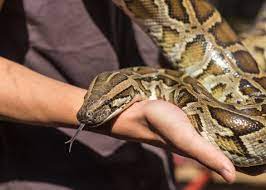The Burmese python, one of the largest snake species in the world, often captivates the imagination with its impressive size and striking appearance. However, alongside fascination comes curiosity, particularly regarding their temperament and behavior. Among the myriad questions that arise, one frequently asked is, “Are Burmese pythons aggressive?”
Burmese pythons aren’t typically considered aggressive toward humans unless they feel threatened or are provoked. They are large constrictors, so if they feel cornered or scared, they may defend themselves. However, in their natural habitat, they tend to be shy and reclusive.
The perception of aggressiveness might also depend on individual temperament and previous experiences. It’s essential to treat any wild animal with respect and caution.
Understanding Burmese Pythons

Burmese pythons are fascinating creatures. They’re one of the largest species of snakes in the world, native to Southeast Asia, particularly Myanmar (formerly Burma), hence their name. Here are some key points to help you understand them better:
- Physical Characteristics: Burmese pythons are large and robust snakes, with adults typically reaching lengths of 12 to 18 feet, though some individuals have been recorded at over 20 feet. They have muscular bodies covered in smooth scales, with patterns that vary from light tan to dark brown, often with blotches or markings that help them blend into their environment.
- Habitat: In their native range, Burmese pythons inhabit a variety of habitats, including forests, grasslands, marshes, and even agricultural areas. They are excellent swimmers and are often found near water.
- Diet: These pythons are powerful constrictors, meaning they squeeze their prey until it suffocates. Their diet mainly consists of mammals, birds, and occasionally reptiles. They are ambush predators, lying in wait for unsuspecting prey to pass by.
- Reproduction: Burmese pythons are oviparous, meaning they lay eggs. Females typically lay clutches of 12 to 36 eggs, which they incubate by coiling around them to provide warmth. After about two to three months, the eggs hatch, and the young are independent from birth.
- Invasive Species: Unfortunately, Burmese pythons have become established in parts of the United States, particularly in the Florida Everglades, where they were likely introduced through the pet trade. They have become a highly invasive species, with negative impacts on native wildlife populations.
- Conservation: In their native range, Burmese pythons are threatened by habitat destruction and the illegal wildlife trade. Efforts are underway to protect their habitats and regulate the trade of these snakes to ensure their survival in the wild.
Understanding Burmese pythons involves recognizing their role in their ecosystems, their behaviors, and the challenges they face both in their native habitat and in regions where they’ve become invasive.
Are burmese pythons aggressive?
Burmese pythons are generally not considered aggressive towards humans, but like any large snake, they can be dangerous if mishandled or if they feel threatened. In their natural habitat, Burmese pythons are typically solitary and elusive, preferring to avoid confrontation with humans. They are known to be relatively docile when handled by experienced individuals.
However, it’s essential to remember that these are powerful constrictors capable of inflicting serious harm if they feel threatened or cornered. In the wild, they may defend themselves if they perceive a threat, and captive individuals can react similarly if they feel stressed or frightened.
Proper handling and respect for the snake’s space are crucial to minimize the risk of aggression or defensive behavior. Responsible ownership and adherence to safety protocols are essential for anyone who keeps Burmese pythons or interacts with them, whether in captivity or in the wild.
Factors Influencing burmese pythons Aggression
Several factors can influence the behavior and potential aggression of Burmese pythons:
- Stress: Like many animals, Burmese pythons may become defensive or aggressive when stressed. Stressors can include loud noises, sudden movements, handling by unfamiliar individuals, overcrowded enclosures, or changes in their environment.
- Hunger: A hungry snake may be more likely to exhibit aggressive behavior, especially if it perceives a nearby human or animal as potential prey. It’s essential to feed captive Burmese pythons regularly and adequately to help prevent this.
- Protecting Territory or Offspring: While Burmese pythons are typically solitary animals, they may become defensive if they perceive a threat to their territory or offspring. This defensive behavior is more common during the breeding season or when guarding a nest of eggs.
- Health Issues: Illness or injury can cause discomfort and stress in Burmese pythons, leading to defensive or aggressive behavior. It’s crucial to monitor the health of captive snakes and seek veterinary care if any signs of illness or injury are observed.
- Handling: Improper handling techniques or rough treatment can cause stress and fear in Burmese pythons, leading to defensive behavior. Handlers should approach snakes calmly and gently, avoiding sudden movements or actions that may startle them.
- Previous Experiences: Burmese pythons can learn from previous interactions and experiences. If a snake has had negative encounters with humans or other animals in the past, it may be more likely to exhibit defensive behavior in similar situations in the future.
- Individual Personality: Like humans, each Burmese python has its own unique personality and temperament. Some individuals may be more docile and tolerant of handling, while others may be more prone to defensive or aggressive behavior.
Understanding these factors can help snake owners and handlers anticipate and mitigate potential aggression in Burmese pythons, promoting safer interactions for both humans and snakes.
Safety Precautions for Interacting with Burmese Pythons

Interacting with Burmese pythons, or any large snake, requires caution and respect for their capabilities and behaviors. Here are some safety precautions to consider:
- Handling Techniques: Learn proper handling techniques from experienced individuals or herpetologists before attempting to handle a Burmese python. Always support the snake’s body and avoid grabbing or restraining it by the head or tail, which can stress the animal and increase the risk of defensive behavior.
- Approach Calmly: When approaching a Burmese python, do so slowly and calmly to avoid startling the snake. Sudden movements or loud noises can stress the snake and increase the likelihood of defensive behavior.
- Supervision: Never handle a large snake alone, especially if you’re inexperienced. Always have another person present who can assist in case of an emergency.
- Respect Their Space: Give the snake plenty of space and avoid cornering or crowding it, which can cause stress and trigger defensive behavior. Allow the snake to move freely and retreat if it feels threatened.
- Watch for Signs of Stress: Learn to recognize signs of stress in Burmese pythons, such as hissing, defensive posturing, rapid breathing, or striking. If you observe these behaviors, back away slowly and give the snake time to calm down.
- Secure Enclosures: If keeping Burmese pythons in captivity, ensure their enclosures are secure and escape-proof to prevent accidental escapes. Use sturdy locks or latches on doors and lids, and regularly inspect enclosures for any signs of damage or wear.
- Feeding Safety: Use caution when feeding captive Burmese pythons, as they may strike at prey items or mistakenly bite a hand that smells like food. Use feeding tongs to offer prey items and avoid hand-feeding whenever possible.
- Medical Attention: Seek veterinary care promptly if a Burmese python exhibits signs of illness or injury. Handling a sick or injured snake can be dangerous for both the snake and the handler.
By following these safety precautions and treating Burmese pythons with respect, handlers can minimize the risk of accidents or injuries during interactions with these impressive reptiles.
Tips for responsible ownership of Burmese pythons
Responsible ownership of Burmese pythons involves providing proper care, ensuring the snake’s welfare, and adhering to legal regulations. Here are some tips for responsible ownership:
- Research: Before acquiring a Burmese python, thoroughly research their care requirements, behavior, and potential lifespan. Make sure you understand the commitment involved in caring for a large snake.
- Habitat: Provide a spacious and secure enclosure that meets the snake’s needs for temperature, humidity, and space to move and explore. Consider factors like substrate, hiding spots, climbing branches, and water bowls when setting up the enclosure.
- Temperature and Humidity: Maintain appropriate temperature gradients and humidity levels within the enclosure to mimic the snake’s natural habitat. Use thermostats, hygrometers, and heating devices to regulate these conditions effectively.
- Feeding Schedule: Establish a regular feeding schedule based on the snake’s age, size, and dietary needs. Offer appropriately sized prey items and avoid overfeeding, which can lead to obesity and other health issues.
- Health Monitoring: Monitor the snake’s health regularly by observing its behavior, appetite, and appearance. Look out for signs of illness or injury, such as lethargy, respiratory issues, abnormal shedding, or changes in skin condition.
- Handling: Handle the snake gently and confidently, supporting its body to minimize stress and prevent injury. Avoid handling during feeding or digestion, as well as during shedding or when the snake is in a defensive posture.
- Education: Stay informed about current best practices in reptile husbandry and seek advice from reputable sources, such as experienced breeders, veterinarians, or herpetological societies. Attend workshops or seminars to enhance your knowledge and skills as a snake owner.
- Legal Compliance: Familiarize yourself with local regulations and laws concerning the ownership of Burmese pythons or other exotic pets. Obtain any necessary permits or licenses required for keeping these snakes legally.
- Responsible Breeding: If breeding Burmese pythons, do so responsibly by ensuring proper care and housing for the parent snakes and providing adequate resources for the offspring. Avoid overbreeding or producing more snakes than you can responsibly care for or find suitable homes for.
- Community Engagement: Engage with the reptile-keeping community to share knowledge, exchange experiences, and support initiatives aimed at promoting responsible ownership and conservation efforts.
By following these tips and prioritizing the welfare of your Burmese python, you can be a responsible and conscientious owner, contributing to the well-being of these magnificent reptiles in captivity.
Conclusion
This page answers the question on are burmese pythons aggressive. While Burmese pythons are not inherently aggressive, their behavior can be influenced by various factors such as stress, hunger, and territorial instincts.
Responsible handling, proper care, and understanding of their needs are crucial in minimizing the risk of aggression and ensuring safe interactions with these remarkable snakes. Overall, while caution should always be exercised, with proper care and respect, Burmese pythons can be fascinating and rewarding pets.

